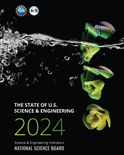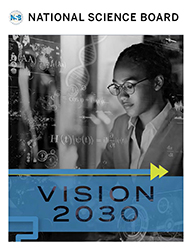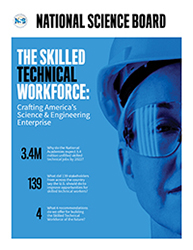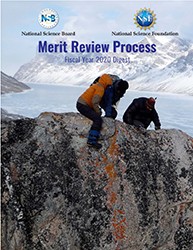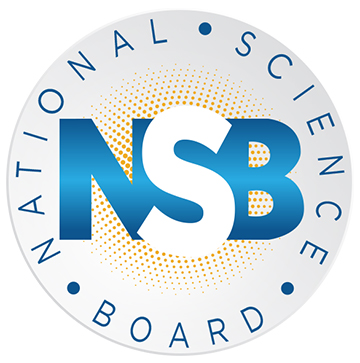
Driving the next decade of American discovery and innovation
New report lays out roadmap for U.S. to remain preeminent in science and engineering
_b7ae2dc4-463f-4d51-9bb4-7396fdf7ef3e.png)
Cover of NSB Vision 2030 report (Credit and Larger Version)
May 5, 2020
Today, the National Science Board (NSB) released a new report that identifies threats to the U.S. science and engineering (S&E) enterprise on which the health, security, and economic prosperity of Americans depend. In Vision 2030, NSB, the policymaking board of the National Science Foundation (NSF), urges action to retain America’s lead in fundamental research and to increase science, technology, engineering, and mathematics (STEM) skills and opportunities for all Americans, all of which are necessary to empower U.S. businesses to succeed globally.
“This report provides a vision of where the U.S. S&E enterprise must be in 2030 and lays out the actions that the Board, NSF, and others can take to achieve that vision so that America remains a global leader,” said Roger Beachy, NSB Vision 2030 Task Force Chair. “We hope Vision 2030 inspires others to join with NSF to take the actions our country needs.”
The current pandemic highlights the crucial role that S&E play in guiding the U.S. to a better future. Scientists and engineers across the country have joined the fight against COVID-19 and are studying the virus, scaling up manufacturing processes to produce critical equipment, and developing vaccines and treatments. NSF-funded research and education are key foundations for these and other efforts that enhance the lives of people around the globe.
Vision 2030 builds on NSB’s recently released Science and Engineering Indicators, which found that the U.S. is playing a less dominant global role in many S&E areas than it did in preceding decades. Indicators also reported that U.S. K-12 student performance in science and mathematics is mediocre and stagnant and, despite some progress, that women and minorities remain underrepresented in many S&E degree programs and jobs.
“Our nation is no longer the uncontested leader in S&E,” said Diane Souvaine, NSB Chair. “We cannot be complacent. We must adapt. As we look to the end of the COVID-19 pandemic and beyond, we can be sure that scientific discoveries and inventions will continue to open new, unexpected frontiers that benefit us all.”
Focus on the Future
The Board’s vision is for the U.S. to retain and enhance its global S&E leadership, offering unparalleled opportunities for students, researchers, workers, and entrepreneurs. Key leadership elements include being on the forefront of the practice of science, a strong STEM talent pool both for research and development and for a range of jobs across the economy, leading-edge and widely accessible research infrastructure, and robust strategic partnerships.
Realizing this vision will require all entities in America’s S&E ecosystem to act. The NSB will focus its efforts on enabling faster translation of NSF-funded research outcomes to benefit the U.S. economy, developing America’s STEM talent, expanding innovation capabilities across the country, and fostering a global community of scientists and engineers who share core values.
NSB commits – in partnership with NSF and other leaders in the S&E enterprise – to a number of actions that include:
- Undertaking an organizational review of NSF and offering recommendations on changes to directorate structure, funding models, and programmatic offerings.
- Convening university, industry, and state partners to identify best practices and regulatory, structural, or administrative barriers to partnerships and translation of NSF-funded research.
- Engaging with Congress and the Administration about the benefits of a new federal program for public post-secondary education institutions that would develop STEM-capable Americans in every state.
- Working with NSF to develop and expand the agency’s strategies and partnerships to grow international collaborations, attract global talent, and create international education and training opportunities.
“We are currently facing unprecedented challenges as a nation, but we will persevere together as we have done in the past with NSF and the U.S. S&E enterprise playing a key role,” said Kelvin Droegemeier, Acting NSF Director. “The Board’s Vision report will help guide the U.S. S&E enterprise over the next decade to continue to push the frontiers of science, speed the path from discovery to innovation, and build the workforce of the future.”
In developing its report, the Board spent over a year reviewing Indicators data, revisiting internal and external reports, and consulting with participants across the S&E community. The NSB held 12 listening sessions around the country to hear directly from individuals hailing from some 70 organizations, including colleges, universities, philanthropies, businesses, and scientific and academic associations, as well as from NSF.
“The Board is grateful to everyone who participated in the listening sessions and shared their insights with us,” said Ellen Ochoa, NSB Vice Chair and Vision 2030 Task Force member. “We came away from those sessions with a sense of urgency that we must take actions for the U.S. to remain preeminent in innovation and to ensure that all Americans have the opportunity to benefit from the S&E enterprise.”
NSB’s Vision 2030 report is available at: https://nsf.gov/nsb/publications/vision2030.pdf
About the National Science Board
The National Science Board and the NSF Director jointly pursue the goals and function of the NSF. NSB identifies issues critical to NSF's future and establishes the agency’s policies within the framework of applicable national policies set forth by the President and the Congress. The Board also serves as an independent body of advisors to both the President and the Congress on policy matters related to science and engineering and education in science and engineering. The President appoints NSB’s 24 members—selected for their eminence in research, education, and records of distinguished service—for staggered six-year terms.
Media contact: Nadine Lymn, National Science Board Office, (703) 292-2490, nlymn@nsf.gov
Useful NSB Web Sites:
Home Page: http://www.nsf.gov/nsb
Media Contact: http://www.nsf.gov/staff/staff_bio.jsp?lan=nlymn&org=NSF
News: http://www.nsf.gov/nsb/news
Meetings: http://www.nsf.gov/nsb/meetings
Publications: http://www.nsf.gov/nsb/publications
Facebook: https://www.facebook.com/NationalScienceBoard
Twitter: Twitter: https://twitter.com/intent/user?screen_name=NSF_NSB
YouTube: https://www.youtube.com/channel/UCkrHRzuGSrPp2haQs0T_Pww
To view PDF documents, please download Adobe Acrobat Reader.
